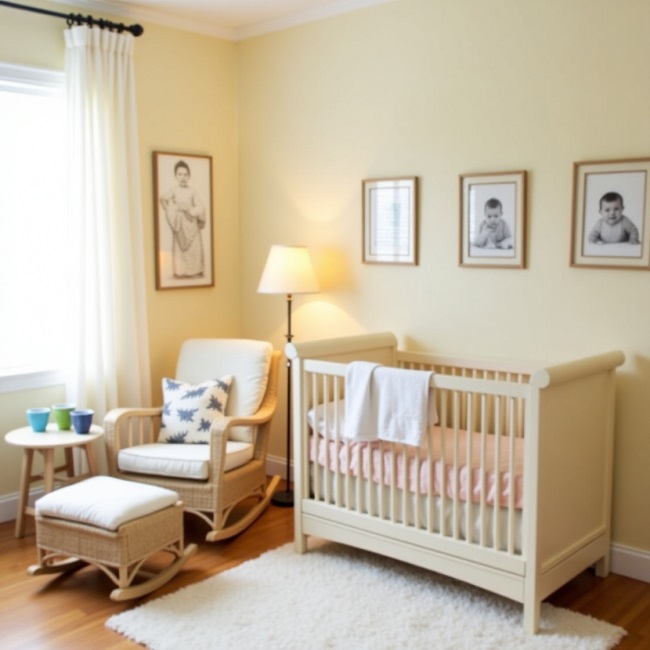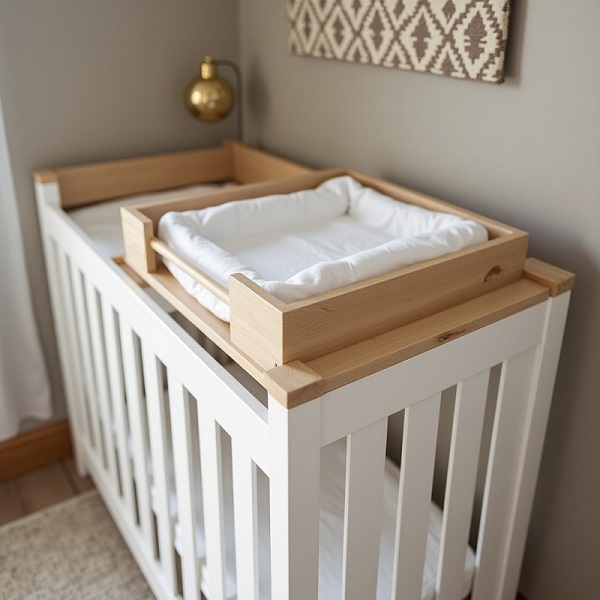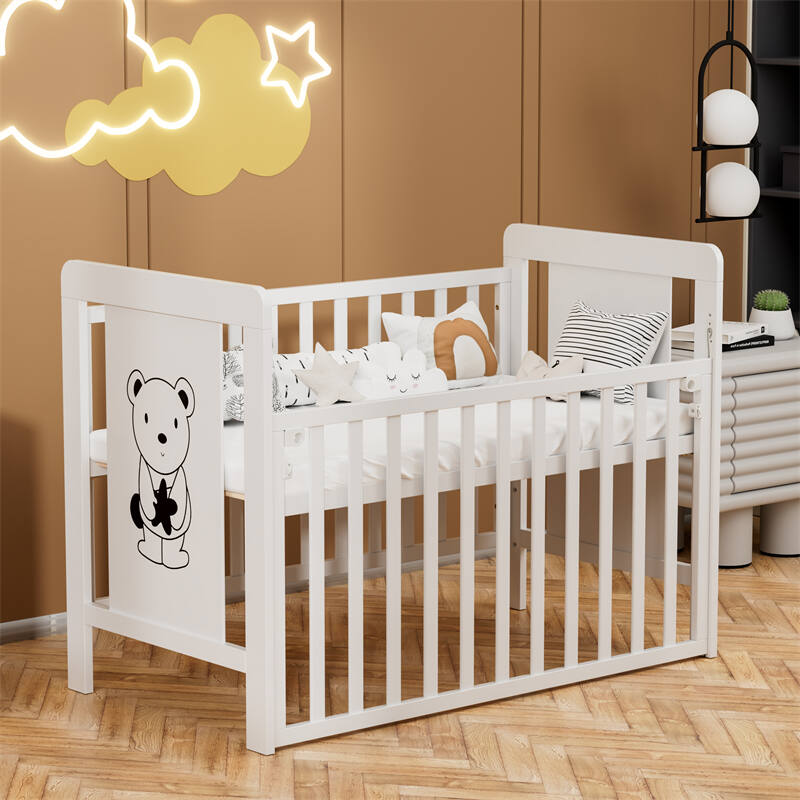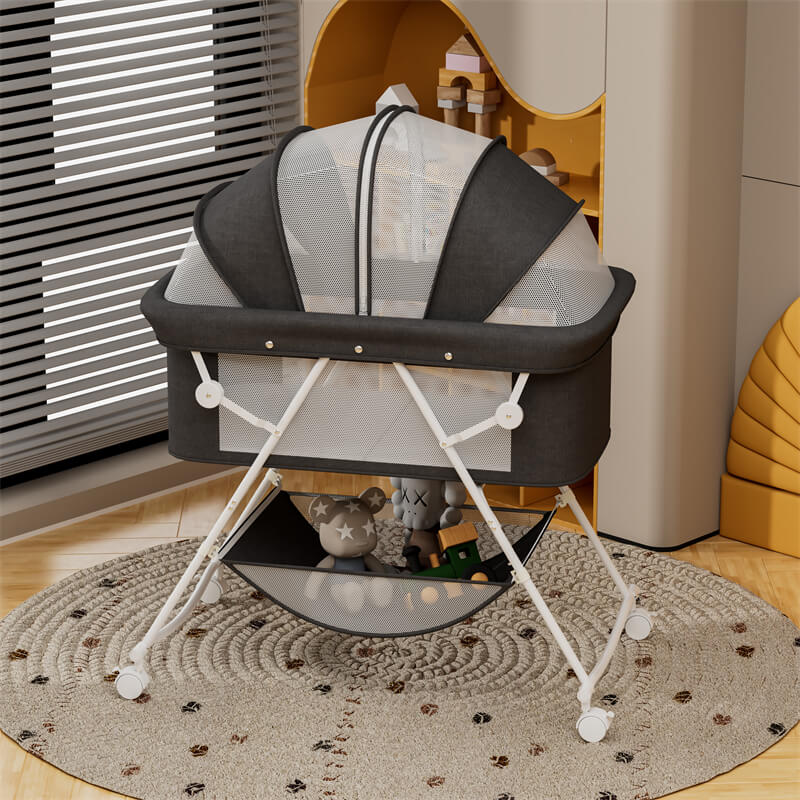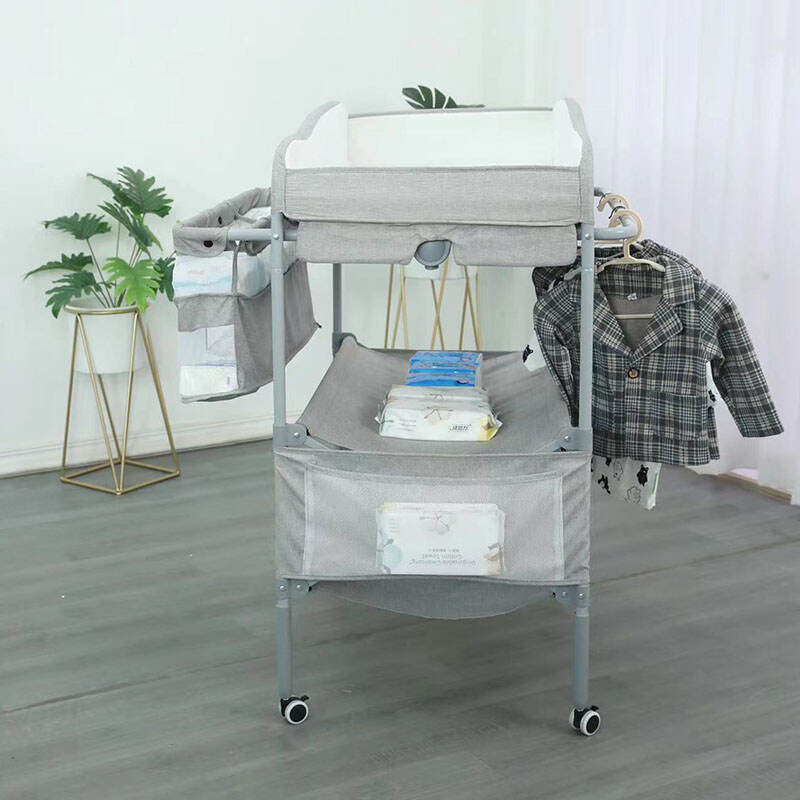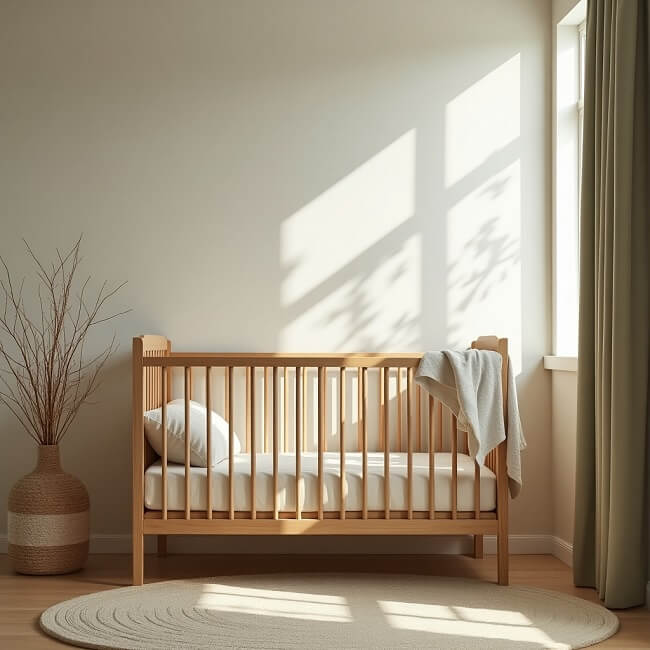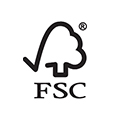Remember that moment when you first walked into the nursery, picturing where the crib would go or how the sunlight would filter through the curtains? But take another look at your carefully decorated baby room: does it really meet safety standards?
Babyproofing the nursery isn’t just about following a checklist; it’s about seeing the room from your little one’s perspective—floor-level, curious, and utterly unaware of dangers. A loose cord, an unsecured drawer, or even a seemingly harmless stuffed animal can become a hazard once your baby starts rolling, crawling, and (eventually) toddling.
The good news? With a little foresight, you can create a space that’s both safe and soothing—for your baby and your peace of mind. Whether you’re setting up the nursery for the first time or reevaluating as your baby grows, this guide will walk you through the key steps to make the room as hazard-free as possible. Because when it comes to safety, there’s no such thing as being too prepared.
When Should You Start Babyproofing the Nursery?
Most safety experts recommend starting basic babyproofing during pregnancy, because let’s face it – you’ll have zero energy for home projects once the baby arrives. That third-trimester nesting instinct is actually nature’s way of getting you to anchor dressers and cover outlets before midnight feedings drain your will to live.
Focus on the big, permanent fixes first – securing baby furniture to walls, setting up the crib safely, and dealing with any obvious hazards like loose cords or unsteady shelves.
The real wake-up call comes around 3-4 months, when your little one starts showing signs of mobility. What begins as an adorable rolling practice quickly escalates into a mission to reach every dangerous object in the room.
By 6 months, assume your baby is training for a baby Olympics. They’ll surprise you with sudden new skills – one day they’re stationary, the next they’re army-crawling toward electrical outlets with frightening determination.
The truth is, babyproofing isn’t a one-and-done project. Start with the basics before birth, then adjust as your baby develops new skills. Staying ahead of their abilities helps prevent accidents before they happen.
What Are the Biggest Safety Hazards in a Nursery?
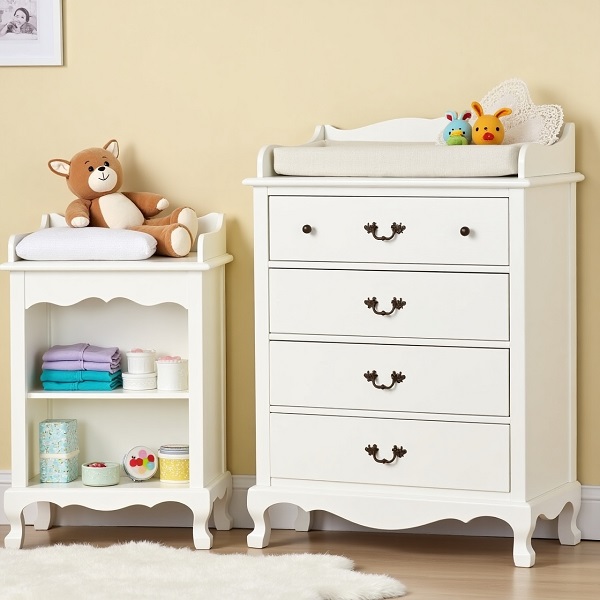
New parents often don’t realize how many ordinary nursery items can become dangerous once babies start moving. After working with child safety experts and seeing countless “how did that happen?” moments, these are the hazards worth your immediate attention:
Furniture Dangers
- Unanchored dressers, bookshelves, or changing tables that can tip over
- Unstable rocking chairs or gliders that little fingers can get caught under
- Heavy decor items placed on high shelves that could fall
Sleep Area Risks
- Crib bumpers, loose bedding, and soft toys can all raise the risk of sudden infant death syndrome (SIDS).
- Spaces between the mattress and crib sides create dangerous gaps where babies can become trapped.
- Drop-side cribs (which have been banned but sometimes get passed down)
Window Hazards
- Blind cords within reach (a strangulation risk)
- Can open windows more than 4 inches
- Unsecured window screens that don’t prevent falls
Electrical & Small Object Dangers
- Uncovered electrical outlets
- Cords from monitors, night lights, or chargers
- Small items like pacifier parts, toy pieces, or decorative objects
Other Overlooked Risks
- Changing tables without safety straps
- Unsecured diaper pails or trash cans
- Medications or creams left within reach
- Plants that may be toxic if ingested
The scary part? Many accidents occur with objects parents assumed were safely out of their child’s reach. Babies develop new skills overnight – rolling at 3 months, crawling by 6 months, and climbing before their first birthday. What’s safe today might be dangerous tomorrow.
Pro tip: Get down on your hands and knees to see the room from your baby’s perspective. You’ll spot hazards you never noticed from adult height. And remember – no amount of babyproofing replaces adult supervision, but it does give you crucial extra seconds to intervene.
How to Make the Crib Area Safe?
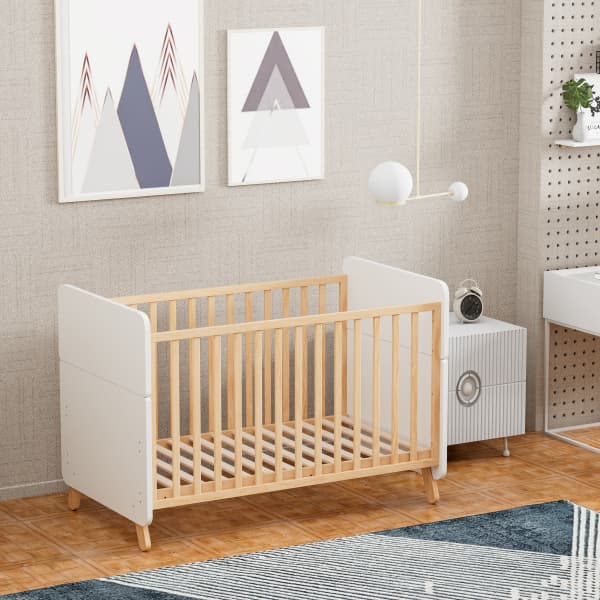
That beautiful crib you spent hours selecting? It becomes ground zero for safety the moment you put your baby down to sleep.
The safest crib looks almost shockingly bare. Ditch the bumper pads (yes, even the “breathable” ones), remove all pillows and stuffed animals, and skip the cozy-looking blankets. I know it feels stark, but the American Academy of Pediatrics is clear: babies should sleep on a firm, flat surface with nothing but a fitted sheet for the first year. Those adorable nursery photos with plush bedding? Pure fantasy – and dangerous reality.
Mattress matters more than you think. Always place the mattress at the correct height – the highest level for newborns, lowering it as your baby grows. No more than two fingers should fit between the mattress and crib sides. In addition, if you press the mattress and it leaves an indentation, it’s too soft.
When your baby tries to start standing, lower the mattress to its lowest position immediately, and remove any hanging mobiles or toys. Remember to check for teething marks on the railings (they can create splinters).
For parents using:
- Bassinets: Transition to crib when baby can roll over or reaches weight limit
- Crib tents: Not recommended due to entanglement risks
- Convertible cribs: Ensure all conversion parts are manufacturer-approved
How to Secure Furniture and Prevent Tip-overs?
That adorable dresser you lovingly picked out? It’s a potential death trap waiting to happen. A child may pull open the drawers of his dresser, using them as stairs to reach a toy on top.
The Anchoring Imperative
Every single piece of tall, heavy furniture in your nursery needs to be secured to the wall. Not just the dresser, but bookshelves, changing tables, even that cute little wardrobe. The process is simpler than you think:
- Locate wall studs (a $10 stud finder pays for itself in peace of mind)
- Use furniture straps or brackets (the metal ones are more durable than plastic)
- Attach to the furniture’s solid frame, not just the back panel
Furniture Placement Tricks
The placement of furniture is just as important as securing it properly when ensuring a safe environment for children. Avoid placing enticing items like toys, remotes, or stuffed animals on top of furniture, as they can encourage children to climb. Put heavier items in the bottom drawers to lower the center of gravity. Most importantly, avoid positioning furniture near cribs or play areas where falls would be most dangerous
Drawer Dangers You’re Overlooking
Drawers themselves create multiple hazards:
- Install drawer stops to prevent them from being pulled all the way out
- Install childproof latches to restrict how far drawers can open
- Never leave drawers partially open (makes perfect climbing steps)
The Forgotten Furniture
These often get missed:
- TV stands (if you have a monitor screen in the nursery)
- Floor lamps
- Rocking chairs (can pinch little fingers)
- Bookcases (even short ones become climbing challenges)
How to Keep Electrical Outlets and Cords Safe?
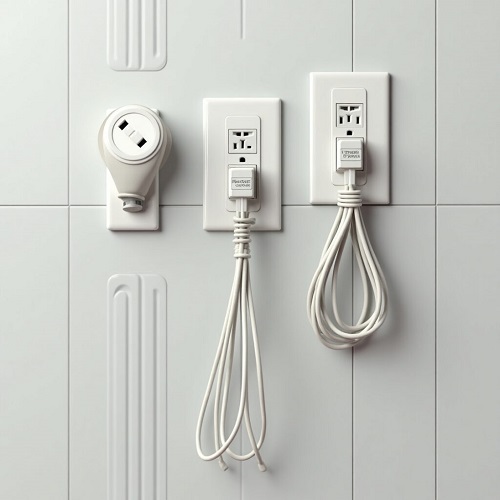
The reality is that electricity is one of the most dangerous hazards in any home, but also one of the easiest to safeguard against. A few dollars spent on quality outlet covers and some thoughtful cord management can prevent tragedies that no parent should ever have to face.
The basic plastic outlet covers we all grew up with? They’re better than nothing, but today’s safety experts recommend more secure options. Look for sliding outlet covers that automatically close when not in use, or spring-loaded models that require equal pressure on both sides to open.
Electrical cords pose a double threat – they’re both a strangulation hazard and an electrocution risk. Start by running cords behind furniture whenever possible, using cord shorteners to eliminate slack.
Never let charger cords dangle within reach, and be especially vigilant about monitor cords near the crib. Those cute string lights you hung for ambiance? Either remove them entirely or secure them high up where tiny hands can’t wrap them around little necks.
That power strip behind the dresser might seem harmless, but to a crawling baby, it’s a treasure trove of dangerous discoveries. Use power strip covers that completely encase the unit and its cords, or better yet, mount it out of reach.
How to Keep Windows, Blinds, and Curtains Safe?
Windows might seem harmless until you witness your toddler’s determination to reach one. What adults perceive as a simple view, curious children often see as an exciting invitation to explore the unknown.
That cozy reading nook by the window? It’s actually a step stool in disguise. Keep all furniture – especially cribs, changing tables, and bookshelves – at least three feet away from windows. Children will use whatever they can to boost themselves up—and it only takes one successful climb to access an unsecured window.
That screen you think is providing protection? It won’t stop a determined child. Window screens are meant to block insects, not to prevent children from falling—they offer no protection against a child pushing through. For any window above the first floor, install proper window guards that screw into the frame and can withstand pressure.
Therefore, window locks are essential, but not all are created equal. Simple sash locks prevent windows from opening more than 4 inches – enough for ventilation but not enough for a child to squeeze through.
Those elegant window treatments with dangling cords? The cords can form deadly loops in seconds – it takes less than 30 seconds for a child to lose consciousness if a cord wraps around their neck. Replace all corded blinds with cordless alternatives or retrofit them with safety devices that keep cords taut and out of reach.
How to Organize Nursery Items to Avoid Choking Hazards?
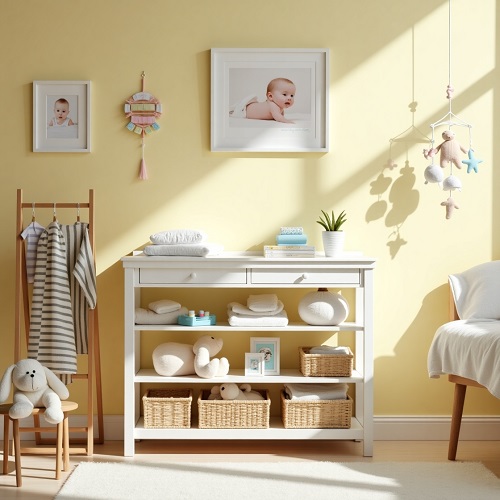
You’ve babyproofed the outlets and anchored the furniture, but the most insidious dangers in your nursery might be hiding in plain sight. For example, something unidentifiable that a child puts into his or her mouth. Nothing ruins the peace of a quiet nursery like the terrifying silence of a child who’s found something they shouldn’t have in their mouth.
Every parent needs this simple trick: if an item fits through a standard toilet paper tube (about 1.25 inches in diameter), it’s a potential choking hazard. Walk through the nursery with this mental filter, examining everything at your child’s eye level.
The diaper bag in the nursery can be like a black hole, always finding loose pacifier parts, stray medicine bottle caps, random coins, and broken snack box lids. You should make it a habit to empty and inspect the bag daily – it’s shocking what accumulates in those pockets.
As long as you pay attention to the organization and placement of baby products, half of the safety protection of the nursery is already achieved. You can use clear bins with secure lids for small items. Shelves holding hazardous items should be installed at a minimum height of 5 feet to keep them safely out of children’s reach.
Your nursery is probably filled with stuffed animals, but it’s time to remove any with:
- Plastic eyes or noses that could detach
- Ribbons or strings longer than 6 inches
- Stuffing that could leak out if torn
- Small accessories like miniature bottles or buttons
Next, you should check the baby furniture again, but focus on small parts that could fall off. Run your hands along the edges of the furniture to check:
- Loose hardware (screws, knobs, drawer pulls)
- Peeling veneer or splinters
- Small decorative items within reach
- Drawer contents that may shift downward
What Babyproofing Products Should You Have in the Nursery?
Absolute Essentials
✅Furniture anchors (heavy-duty): Metal L-brackets that bolt dressers and bookshelves directly to wall studs.
✅Self-closing outlet covers: Spring-loaded models that automatically seal when not in use.
✅Cord management system: Paintable channels or adhesive clips to secure every wire (monitors, night lights, chargers).
✅Door pinch guards: Soft silicone protectors for hinge-side finger protection.
Often Forgotten But Crucial
✅Window stops: Mechanical limiters that prevent windows from opening more than 4 inches.
✅Drawer/door latches: Magnetic or adhesive models that withstand toddler tugs.
✅Corner cushions: For sharp furniture edges at crawling/standing height.
✅Crib rail covers: Breathable teething guards for when chewing begins.
Specialized Solutions for Common Hazards
✅Anti-slip rug pads: For play areas on hardwood floors.
✅Closet rod locks: Prevent hanging clothes from becoming climbing aids.
✅Low-profile door stoppers: Let adults open fully, but stop toddler fingers from getting crushed.
✅Appliance locks: For any electronics with accessible buttons (sound machines, humidifiers).
Conclusion
As parents, we’re all just doing our best to stay one step ahead of those tiny, curious hands that seem to find every potential danger we overlook.
The truth is, no amount of babyproofing can eliminate every risk, but the right precautions can prevent the most serious accidents. What matters most isn’t having the fanciest gadgets or the most Instagram-worthy nursery setup—it’s about creating a space where your child can safely explore, discover, and grow.
Keep in mind that babyproofing needs to adapt continually as your child grows and gains new abilities. That dresser you anchored so securely? It’ll need rechecking when your toddler discovers they can use toys as hammers. Those outlet covers that worked perfectly at 6 months? They’ll need upgrading when little fingers get stronger.
Recommended Related Articles:
- Baby Furniture for Small Spaces: Maximizing Your Nursery
- Essential Baby Furniture: What Your Nursery Needs?
- Exploring 11 Different Types of Baby Furniture
- How to Choose Furniture for a Nursery?
- Crib Types and Styles: A Complete Guide
- Best Materials for Baby Crib
- Bassinet Vs Crib Vs Cradle: Which Should You Choose?
- Best Bassinet for Small Spaces: A Complete Guide

